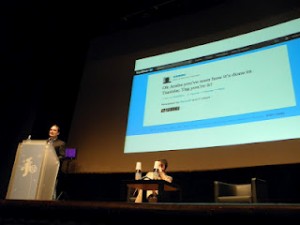Tweeting the Arab Spring: capturing history, 140 characters at a time
 Andy Carvin, senior strategist at the NPR, gave a keynote address today in Teatro Pavone, discussing his observations on the role of Twitter in the Arab Spring. Twitter calls upon the memory and knowledge of millions of people, and serves as a narrative of revolution and change.
Andy Carvin, senior strategist at the NPR, gave a keynote address today in Teatro Pavone, discussing his observations on the role of Twitter in the Arab Spring. Twitter calls upon the memory and knowledge of millions of people, and serves as a narrative of revolution and change.
Carvin observes that his use of Twitter began in a rather banal manner: tweeting about watching his wife make hummus and his daughter playing in the kitchen. At first, he did not see its many applications. “It seemed like a fun place to chat with people… like you were at a diner or a bar,” he says. It was only after the assassination of Benazir Bhutto that he was able to see its manifold uses.
At first the reports of her death were too vague to be believed, but through Twitter Carvin was able to connect with a Pakistani watching local news and affirm that Bhutto’s death was being reported on television. From this, Twitter’s use as a place to ask questions and fact check took on greater significance.
By the time the Arab Spring came around, Carvin had become fluent in Twitter’s various uses. He became fascinated with the twitter accounts of revolutionaries in Libya, Tunisia and Egypt. Speaking of the tweets during the protests in Egypt, he says, “By observing them collectively it almost felt as though I was in a virtual helicopter floating over Tahrir Square, when in reality I was sitting in my office in Washington DC.”
Carvin found that posing questions about any topic, from help with Arabic translations to the provenance of mysterious weapons, gave him almost instantaneous and accurate results. Calling upon the formidable collective memory of the web, many of his questions were answered within minutes. The most difficult mystery to solve was the true identity of a blogger who had assumed the name and identity of “A Gay Girl in Damascus.” However even in that instance, the blogger’s true identity was discovered within a week.
Through Twitter, Carvin and the “twitterati” of the Arab Spring had access to instantaneous information and could communicate across borders. It completely changed the nature of war and revolution, which in the past relied on war reporters and journalists to report first hand accounts. Iphones in the hands of people in the midst of a street protest fundamentally alter the nature of how war can be represented. Carvin stressed however that both types of reporting must work together however to complete the picture.
Unfortunately, Twitter is limited to those who use it. A certain type of person tends to gravitate towards it: one who is technologically savvy and English-speaking. A large segment of the population is therefore voiceless. And not all events gain attention or are even ever mentioned on the Twittersphere. In other words, Twitter can only go so far. But for those who do choose to use it, Twitter will always remain as a testament to their lives and achievements. Carvin alone has a database of more than 100,000 tweets.
In summary, Twitter is an important tool in hands of a skilled journalist, but cannot be said to “replace” journalism. As Carvin puts it: “I’m conducting journalism. I’m dabbling in journalism… Someone described what I’m doing as deejaying.” These are apt verbs and an apt metaphor. Twitter gives the journalist the power of selection. Ultimately, Twitter provides the world with a far broader and deeper understanding of world events as they unfold.
-Catherine Morris
